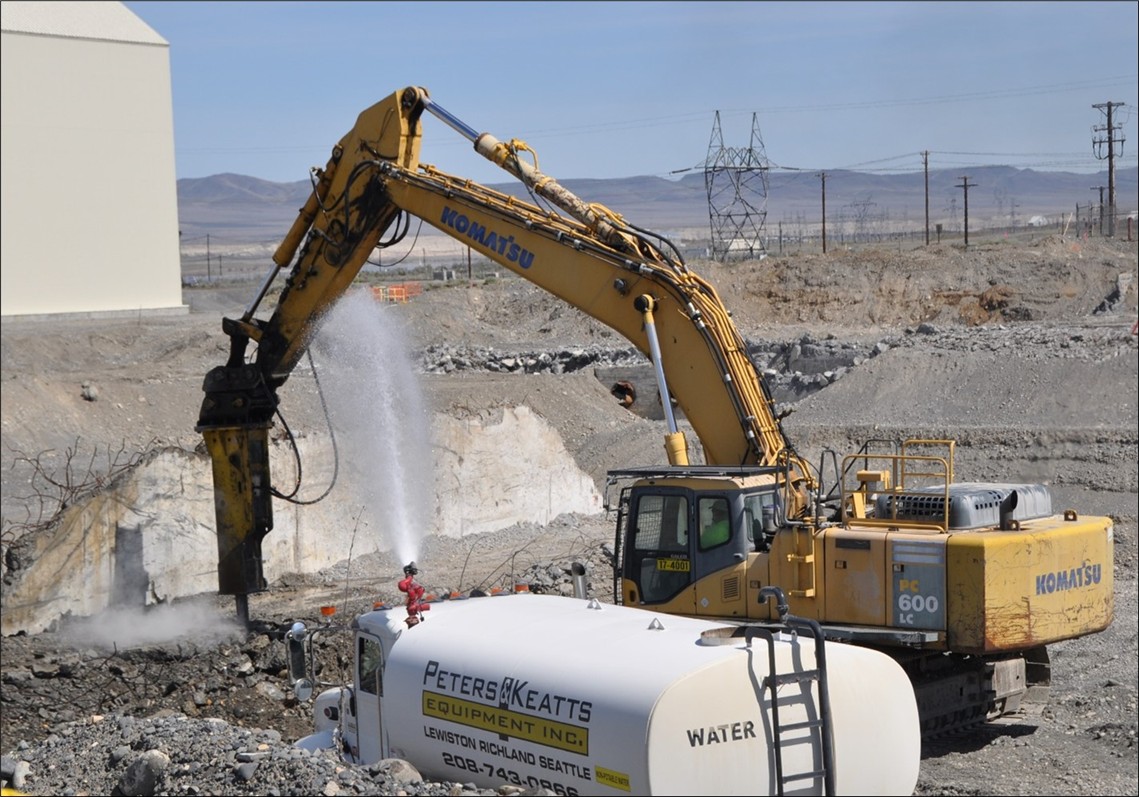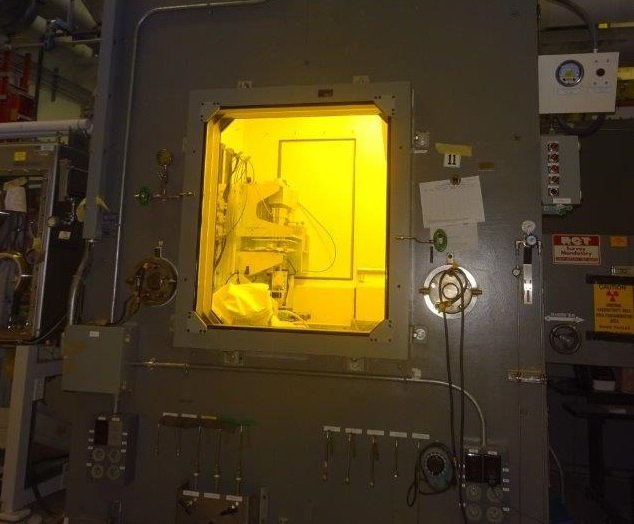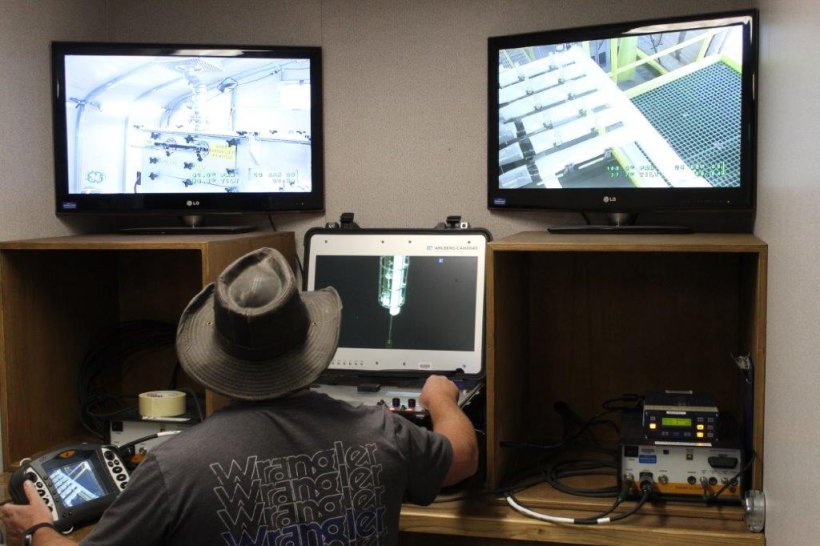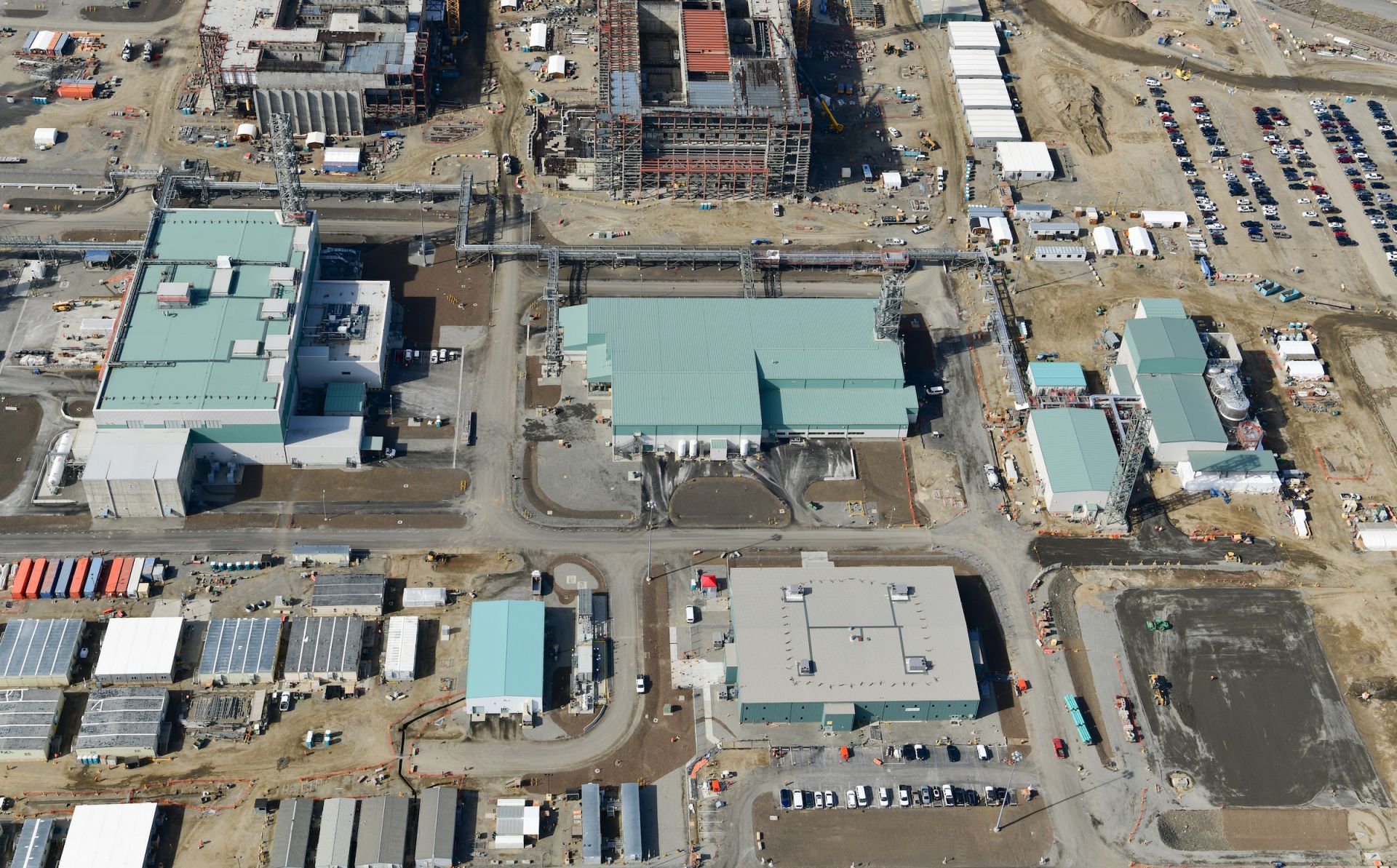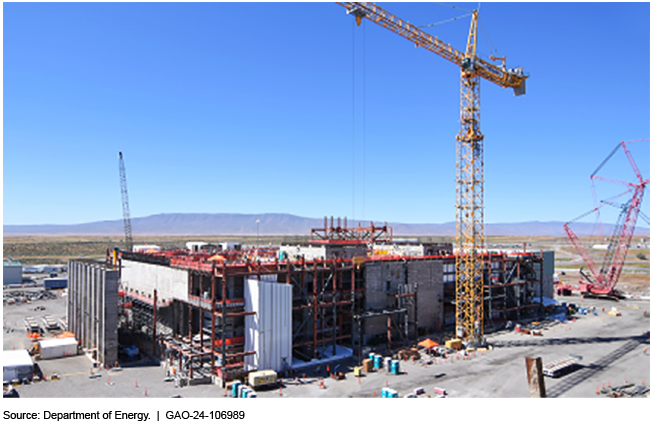A WTP crew vitrified the first Hanford Site tank waste inside one of two melters in the Low-Activity Waste Facility. Top right, a camera inside the melter’s pour cave shows the vitrified waste being poured into a stainless steel container as well as the hot liquid inside the container. Bottom right, the first two containers filled with vitrified waste in the pour cave prior to being lidded, swabbed to verify their exteriors are free of contamination, and then moved into the export bay. (Photos: DOE)
The Department of Energy has announced that the Hanford Site’s Waste Treatment and Immobilization Plant (WTP) has reached a commissioning milestone, producing more than 20 stainless steel containers of immobilized low-activity radioactive waste.
Hanford’s WTP crew celebrate the first vitrification of radioactive waste in the plant’s Low-Activity Waste Facility. (Photo: Bechtel)
The Department of Energy’s Office of Environmental Management and its contractor Bechtel announced on October 15 the start of nuclear vitrification operations at the Waste Treatment and Immobilization Plant (WTP), also known as the Vit Plant, at the Hanford Site in Washington state.
An aerial view of the Hanford Site’s 200 Area and the Waste Treatment and Immobilization Plant, also known as the Vit Plant. (Photo: DOE)
Energy Secretary Chris Wright issued a statement on September 9 denying reports that the Department of Energy plans to terminate the Waste Isolation Pilot Plant (WTP) at the Hanford Site in Washington state.
Lidar technology creates detailed imaging by scanning the interior structure of cocooned reactors at the Hanford Site, supporting future monitoring and safety planning. (Image: DOE)
A new imaging technology is being used on decommissioned reactors at the Department of Energy's Hanford Site in Washington state, revealing a detailed look inside the sealed enclosures.
Hanford contractor teams rehearse procedures for the first transfer of waste from one of the site’s underground tanks to the WTP later this summer. (Photo: DOE)
The Department of Energy’s Office of Environmental Management said that crews at its Hanford Site in Washington state are preparing for the site’s first-ever transfer of radioactive waste from one of its large underground tanks, Tank AP-106, to the Waste Treatment and Immobilization Plant (WTP).
Hanford’s 324 Building, circa 2015. (Photo: DOE)
Working with the Environmental Protection Agency, the Department of Energy has revised its planned approach to remediating contaminated soil underneath the Chemical Materials Engineering Laboratory (commonly known as the 324 Building) at the Hanford Site in Washington state. The soil, which has been designated the 300-296 waste site, became contaminated as the result of a spill of highly radioactive material in the mid-1980s.
Solomon Bairai of Navarro-ATL prepares a Twister Stir Bar sample for analysis at the Hanford Site's 222-S Laboratory. (Photo: DOE)
A new method has received Washington state’s approval for use at the 222-S Laboratory at the Department of Energy’s Hanford Site, improving how experts analyze tank waste and providing more precise data to support safe and efficient cleanup.
Workers offload nitrogen into the LAW Facility at Hanford’s Waste Treatment and Immobilization Plant. The nitrogen, mixed with other materials, will simulate tank waste as the facility prepares for waste operations later this year. (Photo: DOE)
The Department of Energy’s Office of Environmental Management announced that it has introduced waste simulant chemicals to the Hanford Site’s Waste Treatment and Immobilization Plant (WTP) as part of the cold commissioning testing of the plant’s Low-Activity Waste Facility.
Hanford workers move a 330-gallon double-wall transport container of treated tank waste. (Photo: DOE)
As part of its Test Bed Initiative (TBI) demonstration project, the Department of Energy’s Office of Environmental Management completed two shipments of treated, low-activity tank waste from the Hanford Site near Richland, Wash. The approximately 2,000 gallons of TBI waste will be solidified in grout and permanently disposed of at Waste Control Specialists’ (WCS) federal disposal facility in Andrews County, Texas, and at EnergySolutions’ disposal facility in Clive, Utah.
Hanford crews break up concrete and remove contaminated soil near the site’s former K Area reactors in 2023. (Photo: DOE)
The cost to complete the cleanup of the Department of Energy’s Hanford Site in Washington state could cost as much as $589.4 billion, according to the 2025 Hanford Lifecycle Scope, Schedule, and Cost Report, which was released by the DOE on April 15. While that estimate is $44.2 billion lower than the DOE’s 2022 estimate of $640.6 billion, a separate, low-end estimate has since grown by more than 21 percent, to $364 billion.
The life cycle report, which the DOE is legally required to issue every three years under agreement with the U.S. Environmental Protection Agency and Washington State Department of Ecology (Ecology), summarizes the remaining work scope, schedule, and cost estimates for the nuclear site. For more than 40 years, Hanford’s reactors produced plutonium for America’s defense program.
Testing is conducted at the Hanford Site’s Waste Treatment and Immobilization Plant. (Photo: DOE)
The Department of Energy has agreed to hold a 30-day review and comment period on a draft environmental analysis associated with a proposed plan for retrieving, grouting, and transporting some of Hanford’s low-activity tank waste for out-of-state disposal.
Demolition work being conducted on Hanford’s REDOX facility in July 2024. (Photo: DOE)
Work to prepare Hanford’s Reduction Oxide Plant (REDOX) for decontamination and demolition has been put on hold as the Department of Energy shifts focus to higher-priority work at the nuclear site in Washington state.
Using cameras placed inside a temporary shelter, nuclear chemical operator Joe McCoy monitors the pretreatment activities of the Hanford Site’s TBI demonstration. (Photo: DOE-EM)
The Department of Energy’s Office of Environmental Management said that contractors have completed the treatment of 2,000 gallons of radioactive and chemical waste as part of the Hanford Site’s Test Bed Initiative project, which aims to demonstrate the feasibility of alternative options for retrieving and treating low-activity tank waste at the site in Washington state.
Hanford’s Waste Treatment and Immobilization Plant, also known as the Vit Plant. (Photo: Bechtel National)
BWX Technologies announced that the Department of Energy has approved Hanford Tank Waste Operations & Closure (H2C) to begin work under a contract valued at up to $45 billion to clean up tank waste at the Hanford Site near Richland, Wash. H2C is a limited liability company made up of BWXT Technical Services Group, Amentum Environment and Energy, and Fluor Federal Services.
The Hanford Field Office leadership team gathers around a new sign at the Stevens Center Complex in Richland, Wash., on October 1. (Photo: DOE)
Beginning last week, the two Department of Energy offices responsible for the environmental cleanup of the department’s Hanford Site have been combined under a new name: the Hanford Field Office. Previously, management of the 586-square-mile site near Richland, Wash., was split between the Richland Operations Office and the DOE Office of River Protection (ORP).
Hanford’s HLW Facility under construction in early 2024. (Photo: Bechtel National)
The Government Accountability Office has recommended that the Department of Energy put a hold on construction of its High-Level Waste Facility at the Hanford Site near Richland, Wash. The GAO said design and construction of the facility, part of Hanford’s Waste Treatment and Immobilization Plant, also known as the Vit Plant, should be paused until several actions are taken, including considering other alternatives for managing the site’s high-level radioactive liquid waste.












